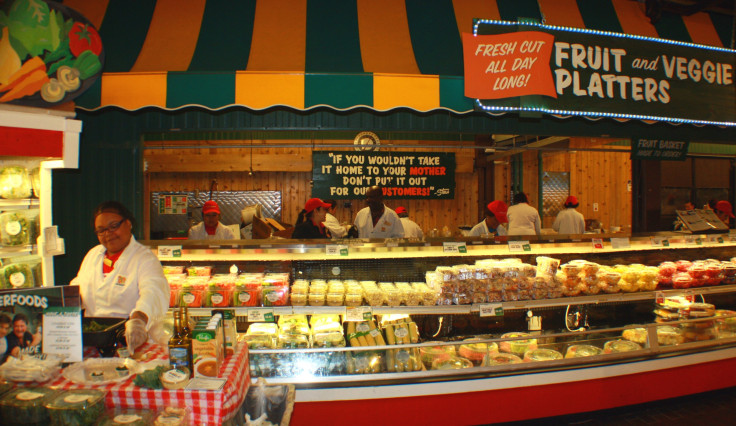How Whole Foods Can Rebuild Its Brand Amid Tough Competition, Customer Defections

Whole Foods Market (NASDAQ:WFM) seemed to have the recipe down. Its distinct identity helped build a loyal base of consumers and brought years of growing revenues. But now -- with the stock still depressed a month after second-quarter earnings fell far below analyst expectations -- investors, grocery insiders and other observers say the retailer needs to rewrite the menu.
The company’s stock, which was trading at more than $57 on Dec. 31, is enduring a persistent slide. On May 7, shares fell from $48 to $38 overnight as investors responded to the company reporting flat second-quarter revenues and downgraded expectations. So far this year, it’s the S&P 500’s worst-performing stock, closing at $37.76 on Monday.
Everyone agrees that Whole Foods needs to change. The question is, how? The company has to make significant moves to recover from its current struggles, said Susan Lee, a project manager at global strategy agency Brand Union in New York.
“I’m waiting to hear some major announcement from Whole Foods over the next month or so to say what it is that they’re planning on doing that is going to be the next revolutionary thing," she said.
It might be a matter of addressing macro-level issues commonly cited by analysts like brand perception and over-saturation of various markets.
But simpler fixes could potentially have a meaningful impact as well. A stroll down the aisles at some of the chain’s innovative competitors reveals a number of store-level and philosophical changes that analysts say could improve the customer experience, offer added value and maybe help Whole Foods begin to reverse the slide.
A different approach
Stew Leonard’s is one such company. With just four supermarkets in Connecticut and Yonkers, N.Y., the quirky, family-owned grocery has established itself over the past 45 years as a community mainstay. Though it logs $341 million in annual sales -- pocket change compared to Whole Foods’ nearly $13 billion -- there are lessons to draw from its particular brand of success.
For example, although Stew Leonard’s says many of its products are 10 to 15 percent cheaper than those of its competitors, customers often consider it a pricey option.
“You’ve got to watch it when you go to Stew’s. It’s very compelling and they offer some great sale prices, but some of their non-sale prices are really expensive,” said taxi driver David Maughan of White Plains, who frequents the Yonkers location.
A similar perception plagues Whole Foods, but Stew Leonard’s has found a way to thrive and increase revenues despite it, according to CEO and President Stew Leonard, Jr., who described his company’s approach at length last week during a tour of the Yonkers market.
"A lot of times you look at this industry and you complicate it too much," he said. "You just have to keep listening and observing and reading about what's happening in the industry ... and a lot of it is listening when customers ask for stuff."

The store itself is wildly different from other supermarkets, with a petting zoo, kids’ events, colorful displays and a mascot in a cow costume who roams the aisles greeting customers. It is a reflection of the philosophy that guides the company, which puts premiums on customer service, family friendliness and maintaining a lean, flexible inventory of fresh products and prepared foods.
About 80 percent of the company’s offerings are perishable, and each store only carries about 2,200 items, versus more than 40,000 at typical supermarkets. The limited selection keeps the stores’ inventory nimble and tailored to local shoppers’ preferences, which the company tracks closely through customer focus groups, visits to competing stores and mining sales data. The approach allows Stew Leonard’s locations to quickly cater to shifting trends and fill niches overlooked by competitors, tactics that analysts say Whole Foods should employ.
“We sometimes look at ourselves more like individual stores in a farmer’s market rather than one supermarket. There’s a fish store, a butcher shop, a bakery,” Leonard said. “In each one we have specific competitors, and we’ll see what they’re doing. If there’s a little mozzarella place on Arthur Avenue in New York, we’ll be there looking at what they’re doing and seeing what works.”
Priced out
One of the most common complaints about Whole Foods has long been the high price of many of its items, a phenomenon that has earned the company the derisive nickname “Whole Paycheck.” Though its products are seen as high-quality, fresh and often organic, many longtime patrons have cut back on trips to Whole Foods as they look to cut their grocery bills.
Former Whole Foods devotee Carol Ann Hafner says she would love to do all of her shopping there, but simply cannot afford it.
“The economy, especially here in New Jersey, is tanking for many middle-class folks, and the extra money for shopping at Whole Foods is drying up,” she said via email. “Personally, I have a few products I will purchase there, but my general fill-up-the-cart-without-a-care shopping does not happen there."
Michal Ann Strahilevitz, a professor of marketing at Golden Gate University in San Francisco, says much of the discussion around Whole Foods’ pricing is misleading, as the company has actually brought many of its price points down. To her, the issue is a failure of messaging: the fact that even long-time fans of the chain are unaware that many of its products -- in particular the items sold under its “365 Everyday Value” store brand -- are becoming more affordable.
“If you shop within their 365 line and also grab the produce that is on sale, you can actually come out of there with more groceries for your dollar than you could have done five or 10 years ago,” she said. “The problem is that most people who are avoiding Whole Foods do not know that.”
The pricing problem is exacerbated by the rise of Sprouts Farmers Market (NASDAQ:SFM), a newer chain of 170 stores taking on Whole Foods by selling organic and health foods at lower prices, leading to an 86 percent jump in second-quarter profits, according to Phoenix Business Journal.
Whole Foods is also feeling pressure from Wal-Mart Stores Inc. (NYSE:WMT) and Target Corp. (NYSE:TGT), which are now offering dozens of organic products.
Innovative ideas
Stew Leonard’s is also well-known for its array of fresh prepared foods, a growing segment of the grocery industry that Lee says Whole Foods needs to embrace.
“I think if they could replicate what Stew Leonard’s and stores like it do -- focus really on more ready-to-eat and prepared foods -- then we’d see the face of the supermarket industry changing,” she said. “Grocery stores that are specialty markets, whether they are organic foods or prepared foods or high-end foods, tend to be more successful than the mass market stores.”
And Stew Leonard’s has embraced innovation and spectacle, broadcasting live streaming video of its dairy farms in the milk aisle, installing animatronic dancers throughout its stores, and offering experiences like made-to-order potato chips and rice cakes.
It’s unclear whether Whole Foods would benefit from adding such offerings, but Lee said that the store should consider rolling out a delivery service, given the market share she believes it has lost to FreshDirect, Peapod and similar companies that ship groceries to online shoppers’ homes.
“I wouldn’t be surprised if they purchase one of these meal delivery services in the next few months," she said. "The only way they’ll be able to get the edge over the possibility of big box retailers getting into the same space they’re in, is if they do something revolutionary.”
The bottom line for Whole Foods is that it needs to more quickly adapt to shifts in the grocery industry and realize that simply being a major player in the health food space no longer guarantees explosive growth.
“How quickly they adapt and how accurately they meet the needs of their shoppers will be a great predictor of their success," said Jeff Weidauer, vice president of marketing strategy at Vestcom, a Little Rock, Arkansas, retail marketing company.
“The competition will continue to come because the market itself is expanding. It’s going to be a lot harder to continue their growth, it’s going to take a lot more work because there’s going be far too many players out there nipping at their heels.”
© Copyright IBTimes 2024. All rights reserved.











